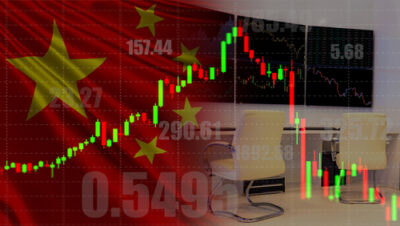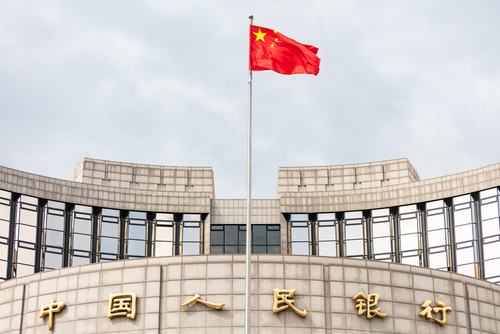Belgium (Brussels Morning Newspaper) When COVID-19 struck, China’s exports plummeted by 17.2% (January-February 2020 figures). In July 2023, they fell off a cliff, down by 14.5% on the heels of a 12% year-on-year drop in June and an almost uninterrupted string of similarly dismal figures since October 2022. Exports to China’s biggest destination, the USA, dropped by a whopping 23%.
This shocked everyone: China has removed its pandemic-related growth-stifling measures at the end of 2022.
Inflation and looming recessions in its target markets coupled with a tripling of benchmark interest rates within one year have all conspired to take a bite out of China’s only path to prosperity: exports. Imports shrank by 12.4% in July as orders for Chinese finished goods dried up and domestic demand declined sharply.
All told China’s growth rate was a measly and unprecedented 0.8% in the second quarter of 2023. Youth unemployment is at 20%. The property sector is teetering on the verge of a meltdown with housing projects uncompleted and mortgage strikes.
The Chinese leadership is convulsing: rapid-fire interest rate cuts by the central bank follow on the heels of delirious stimulus plans released frantically by China’s State Council. Growth is projected to be an increasingly unlikely 5% this year, a disenchanting figure even so.
There is very little room for stimulus spending or tax cuts in the wake of the massive public outlays during the pandemic.
Over the past 15 years, mounting sovereign debt crises in Europe and an anemic rebound in America’s economy were more than offset by the emergence of Asia – and, in particular, China and India – as a global powerhouse.
Yet, the warning signs were there: China’s economic “miracle” has long been based on an artificial rate of exchange for its currency, the Yuan (RMB); on unsustainable dollops of government largesse and monetary quantitative easing which led to the emergence of asset bubbles (mainly in real-estate) and to pernicious inflation; and, frankly, on heavily-redacted statistics.
Real wages have been declining in China for quite a few years now as rural folk moved to burgeoning cities, bad loans proliferated, and consumption remained subdued as savings rates reached malignant, self-defeating levels.
In an effort to sanitize humungous export proceeds, China amassed trillions of dollars worth of foreign exchange reserves, mostly invested in American treasury bonds, creating a dangerous exposure to the vicissitudes of the increasingly-more decrepit US dollar and to America’s downgraded sovereign credit rating.
The Chinese authorities’ attempts to clamp down on rampant speculation and price gouging are too little, too late, not to say irrelevant. The economy will screech to a shuddering halt in the mother of all hard landings. The Chinese House of Cards and Hall of Mirrors will collapse ominously and swiftly.
This will bring the entire global economic edifice into disarray with mounting imbalances and increased risk aversion among investors. The second phase of this oncoming global crisis will resemble closely the Great Depression with massive write-offs in the values of equities, the across-the-board crumbling of entire banking systems, and mounting, two-digit, unemployment rates everywhere.
How to reconcile this doomsday prognosis with China’s uninterrupted string of decades of stellar (often two-digit) annual growth figures?

By seeing China for what it is: the world’s greatest-ever Ponzi scheme. Behind the hype, spin, propaganda, and outright confabulations, China’s economic miracle is founded in its entirety on a simple premise, breathtakingly audacious prestidigitation: a large (equal to two-fifths of GDP) and steadily soaring balance of payments (current account) surplus (mainly with the USA, its addict-partner in this danse macabre) serves to disguise and directly underwrite the fetid outcomes of an all-pervasive state.
These include a mountain range of rotting credits in the state-owned banks and local government; neglected sectors of the lopsided economy; and egregiously misallocated economic resources (mainly in the construction and retail sectors and via huge stimulus packages.)
In many countries government spending translates into GDP “growth” – but China is a special case: most of the seemingly inexorable mushrooming of its GDP had been faked this way in 2007-9, for example.
Indeed, it is China’s very dependence on a weary and wary US consumer which spells its doom when the American music stops. Once it does, China’s investment-driven economy will revert to crippling overinvestment, overcapacity, hidden unemployment, and underemployment. In one word: history’s worst deflation (or, worse yet, stagflation.)
We have seen it all before with Japan. The only difference is that Japan had a real and thriving private sector while China doesn’t: its “private” sector – albeit officially accounting for three-fourths of its GDP – is mostly foreign-owned, export-oriented, or immersed in non-productive operations (read: speculation.)
Large swathes of China’s economy – including and especially the mission-critical financial sector – are in the incompetent and venal hands of China’s decidedly uncivil service and are “managed” (mismanaged rather) by bumbling and provincial party apparatchiks.
To this toxic brew one should add a devastated environment, a dysfunctional judicial system, shoddy accounting practices (including by Western multinationals), stunted capital markets, an obliterated countryside and dying agriculture, and a demographic time bomb: owing to the “one child” policy, China’s population is aging faster than any other major country’s. This is not to mention political risk in an age of Facebook-driven Tweeted revolutions. Hong Kong was just the harbinger.
Opinions expressed in the op-ed section are solely those of the individual author and do not represent the official stance of our newspaper. We believe in providing a platform for a wide range of voices and perspectives, even those that may challenge or differ from our own. As always, we remain committed to providing our readers with high-quality, fair, and balanced journalism. Thank you for your continued support.Sincerely, The Brussels Morning Team



